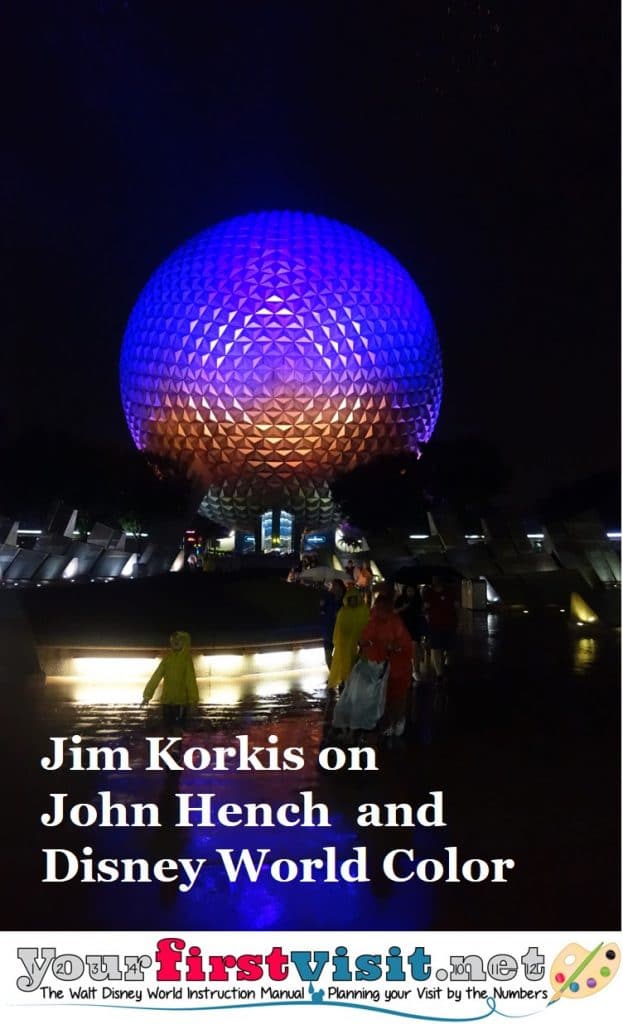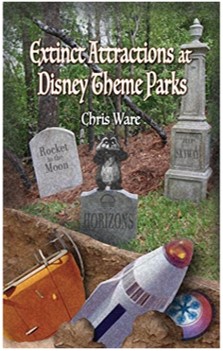Category — A Friday Visit with Jim Korkis
A Friday Visit with Jim Korkis: Pocahontas and Her Forest Friends
Welcome back to Fridays with Jim Korkis! Jim, the dean of Disney historians, writes about Walt Disney World history every Friday on yourfirstvisit.net.
POCAHONTAS AND HER FOREST FRIENDS
By Jim Korkis
Pocahontas and Her Forest Friends was a twelve minute show that opened at Disney’s Animal Kingdom April 22, 1998 and closed September 27, 2008. It was performed in the three hundred and fifty seat Grandma Willow’s Grove theater in the Camp Minnie-Mickey area of Disney’s Animal Kingdom that is now home to Pandora – The World of Avatar.
The show was inspired by the 1995 Disney animated feature film Pocahontas. It was rushed into production so quickly that Disney at first listed it as “Meet the Characters” rather than a stage show in the park guide.
The show was originally called Colors of The Wind, Friends from the Animal Forest, but that was an awkward title that didn’t mention Pocahontas. In fact, early guests just called it the “Pocahontas Show,” so Disney changed the title.
The genesis of the show came from the animal education cast at Disney’s Animal Kingdom. It was meant to be similar to the animal meet-and-greet shows at zoos and other animal parks, where a trainer or two brings out one animal at a time and talks about the animal’s characteristics to the audience.
However, Disney is a storytelling company, and decided to provide an upgraded experience even though the show was intended to be just a placeholder to run for two years or so until Beastly Kingdom was built in the same location. The script was written by Michael Korkis, Bob Glickman and David Duffy, and originally directed by Korkis.
The show was written to utilize the natural behaviors of the animals. The animals sometimes decided they didn’t want to appear which is why so many different types of animals rotated throughout the years in the show.
A live character performer portrayed Pocahontas, and there were two puppeteers who were underneath the stage to operate Sprig and Grandmother Willow. Grandma Willow came from the Disneyland Spirit of Pocahontas show that closed in September 1997.
Pocahontas is worried that the forest is being cut down indiscriminately and runs to Grandma Willow for advice. She reminds Pocahontas of a prophecy that one creature has a special gift to protect the forest but that Pocahontas herself must discover the identity of that creature.
One at a time, several different animals wander onto the stage including at different shows a raccoon, a snake, rabbits, opossums, a skunk, a porcupine, rats and a turkey. Pocahontas talks about what people can learn from each creature. “Every animal has knowledge to share with those who are willing to learn.”
Finally, Pocahontas realizes that the creature of the prophecy must be human beings. “Humans can destroy the forest, but we can also save it. The Earth is our home too. If we take care of it, it will take care of us!”
Since the show was designed for young children, with special seating for them in the first four rows of the theater, the message had to be simple and clear. The show proved so popular that eventually DAK occasionally offered Pocahontas and Her Forest Friends Animal Training Show where the animal handlers demonstrated how they trained the animals for the show.
* * * * *
Thanks, Jim! And come back next Friday for more from Jim Korkis!
In the meantime, check out his books, including his latest, The Unofficial Walt Disney World 1971 Companion: Stories of How the World Began, and Secret Stories of Walt Disney World: Things You Never You Never Knew, which reprints much material first written for this site, all published by Theme Park Press.
Follow yourfirstvisit.net on Facebook or Twitter or Pinterest!!
August 23, 2019 No Comments
A Friday Visit with Jim Korkis: Mission: SPACE
Welcome back to Fridays with Jim Korkis! Jim, the dean of Disney historians, writes about Walt Disney World history every Friday on yourfirstvisit.net.
FUN FACTS ABOUT MISSION: SPACE
By Jim Korkis
At a cost of over a hundred million dollars, Mission: SPACE in Epcot’s Future World opened in 2003, replacing the former Horizons attraction. Mission: SPACE takes place at the 45,000 square-foot ISTC (International Space Training Center) in the year 2036.
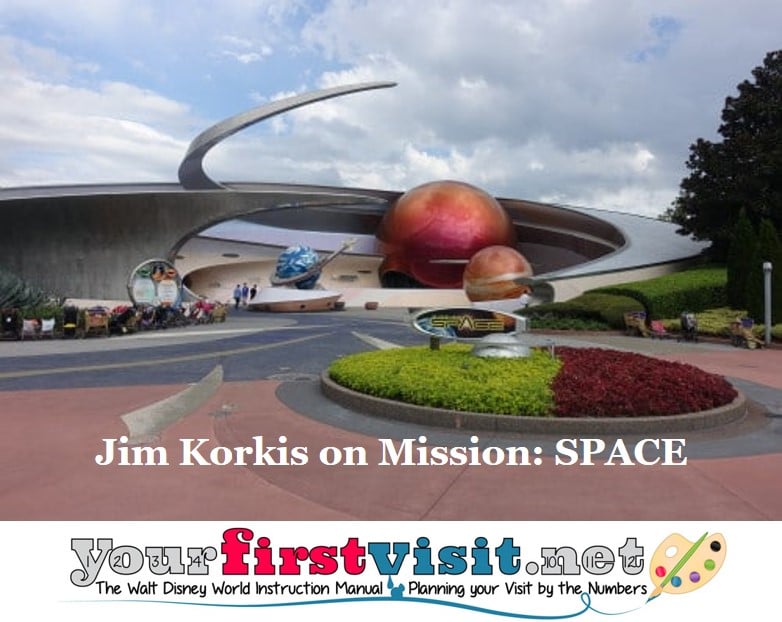
The Orange Mission is a trip to Mars and a descent to the surface. The Green Mission–that does not utilize the centrifuge but includes the tilting–is an orbit of the Earth.
It took more than 650 Walt Disney Imagineers more than 350,000 hours (the equivalent of 40 years of time) to develop Mission: SPACE. The Imagineers’ efforts took place over a five-year period.
Nearly 100 shades of red were tested before Imagineers decided on the color of the red planet that dominates the dramatic facade of Mission: SPACE.
The Gravity Wheel in the Space Simulation Lab rotates at one rotation per minute. It is 35 feet tall and 12 feet wide. The logo of the former Horizons attraction is affixed to the hub. The Horizons logo is also on the front of the cash register counter in the gift shop at the exit of the attraction. The planter in front of the attraction was the planter that formerly contained the Horizons marquee.
At the launch for the Mission: SPACE attraction in 2003 both astronaut Buzz Aldrin (who had shot a commercial promoting the attraction) and astronaut Wally Schirra (who wore a Mickey Mouse wristwatch during his October 1968 Apollo 7 mission) were in attendance.
The LRV (Lunar Rover) suspended from the ceiling in the Sim Lab is on loan from the Smithsonian. According to Walt Disney Imagineering, it is the only LRV constructed by NASA that is not on the moon.
The music was custom-written and scored for this attraction by Trevor Rabin, a one-time member of the rock band Yes, and a prolific composer of motion picture scores.
WDI worked with more than 25 space experts from NASA and Jet Propulsion Laboratory including five astronauts. NASA provided tours, briefings and discussions on current human and robotic missions, as well as the challenges that future missions, like a trip to Mars, might present.
With a career in the NASA space program that spanned more than 30 years, six-time NASA shuttle astronaut Story Musgrave is an ongoing consultant to the attraction. Musgrave describes the attraction as “a place where guests can imagine our future in space and their role in it, walking in the footsteps of heroes and building on the wealth of technology we’ve developed to date.”
Chairman of the Walt Disney Studios Dick Cook began an initiative to turn theme park attractions into films and one of the projects he approved was Brian De Palma’s Mission to Mars (2000). The finished film has little direct relationship to the Mission to Mars theme park attraction but did inspire the Mission: SPACE attraction at Epcot in Florida, with actor Gary Sinise playing the same role he did in the film.
* * * * *
Thanks, Jim! And come back next Friday for more from Jim Korkis!
In the meantime, check out his books, including his latest, The Unofficial Walt Disney World 1971 Companion: Stories of How the World Began, and Secret Stories of Walt Disney World: Things You Never You Never Knew, which reprints much material first written for this site, all published by Theme Park Press.
Follow yourfirstvisit.net on Facebook or Twitter or Pinterest!!
August 16, 2019 No Comments
A Friday Visit with Jim Korkis: The Background to Buzz Lightyear’s Space Ranger Spin
Welcome back to Fridays with Jim Korkis! Jim, the dean of Disney historians, writes about Walt Disney World history every Friday on yourfirstvisit.net.
BUZZ LIGHTYEAR’S SPACE RANGER SPIN
By Jim Korkis
Officially opening on November 23, 1998, Buzz Lightyear’s Space Ranger Spin puts guests in the middle of a giant arcade game, where they shoot at targets with their ion laser cannons to rack up points as they ride in a vehicle called XP-37 Space Cruisers that can rotate 360 degrees. The attraction, even the queue line, is scaled to size of a toy.
The storyline is Evil Emperor Zurg (voiced by Frank Welker) is stealing crystallic fusion cells (that look like batteries) for his Ultimate Weapon of Destruction. Firing at the “Z” emblems (which the Imagineers claimed stood for “Zap!” not “Zurg”) throughout the ride defeats the bad guys and garners points.
New recruits of Star Command (the guests) are sent to defeat him. An audio-animatronics Buzz Lightyear figure (voiced by Pat Fraley) using a Viewmaster explains the mission.
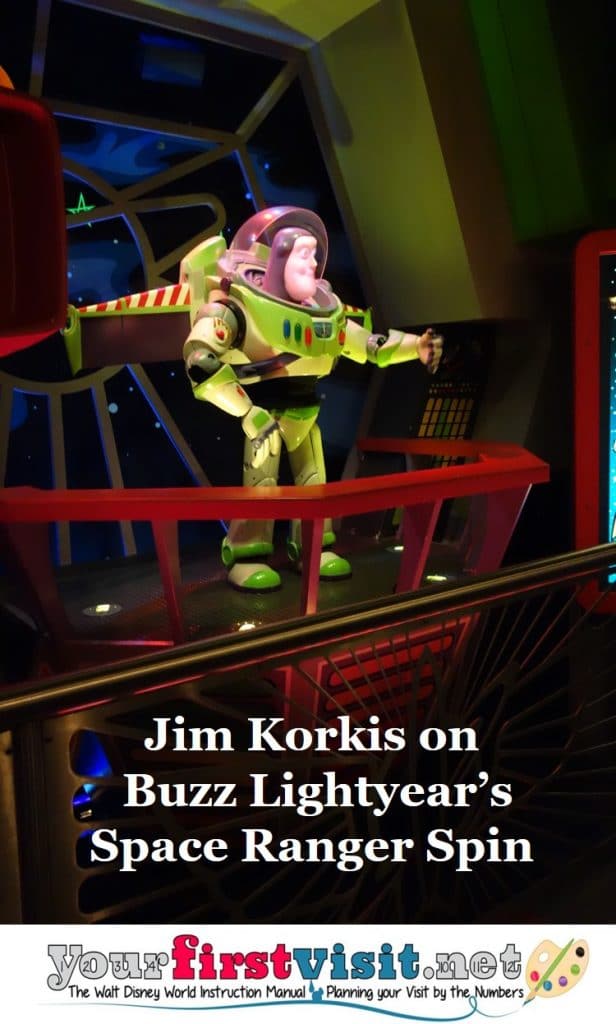
WDI worked closely with Pixar on a full-sized mock-up to animate Buzz’s computer-generated facial expressions, and get them to project accurately from behind on to the translucent mask.
Variations of the attraction can be found at Disneyland, Tokyo Disneyland, Disneyland Paris and Shanghai Disneyland.
The location was previously home to the If You Had Wings attraction (Eastern Airlines) from 6/5/72 through 6/1/87, If You Could Fly (Delta Airlines) from 6/6/87 until 1/3/89 and then Delta Dreamflight from 6/6/89 to 1/1/96. Then it was the unsponsored Take Flight attraction until 1/5/98.
The Imagineers were tasked with using the same walls and ride track under a tight deadline. The same WDI team under the supervision of Paul Osterhout that redid the Enchanted Tiki Room so that it was under new management was put in charge.
They resorted to blacklight paint finishes to simulate some of the dimensionality of the scenery, 3-D painting on interior walls, and computer-generated murals applied to vinyl as cost saving measures.
“The whole thing looks like molded plastic with the big rivet heads and highly polished finishes,” said Osterhout. “It’s like playing in the Buzz Lightyear action playset.
“Tomorrowland is a neighborhood with each building having a public function. We didn’t have a police station before, but now we do – it’s the home of Buzz Lightyear and the Space Rangers.
“We had to take the existing system that moves at maybe three feet per second and make it different and exciting. That’s when we came up with the spin that allows riders to control their own ride vehicle with a joystick making it a different experience every time because the guests have complete control over where the vehicle goes and which targets they shoot at. That’s going to keep them coming back.”
“One of the challenges we face now at the Magic Kingdom is how to introduce the newer ‘classic’ Disney characters to the Park,” explained Imagineering senior vice-president Eric Jacobson. “Characters should live on at the Magic Kingdom. The idea of creating a show about the fantasy world of Buzz Lightyear – not the whole world of Toy Story – in Tomorrowland suddenly clicked. It was a perfect fit.”
* * * * *
Thanks, Jim! And come back next Friday for more from Jim Korkis!
In the meantime, check out his books, including his latest, The Unofficial Walt Disney World 1971 Companion: Stories of How the World Began, and Secret Stories of Walt Disney World: Things You Never You Never Knew, which reprints much material first written for this site, all published by Theme Park Press.
Follow yourfirstvisit.net on Facebook or Twitter or Pinterest!!
August 9, 2019 No Comments
A Friday Visit with Jim Korkis: John Hench and Walt Disney World Color
Welcome back to Fridays with Jim Korkis! Jim, the dean of Disney historians, writes about Walt Disney World history every Friday on yourfirstvisit.net.
JOHN HENCH AND WALT DISNEY WORLD COLOR
By Jim Korkis
In 1990, I got to attend an event in Glendale, California where Imagineer John Hench lectured about color in the Disney theme parks. Hench worked for Disney for 65 years in a variety of capacities, especially when it came to design decisions utilizing color. Here is a short excerpt where he talked about his color choices at Walt Disney World.
“Color is an important part of every environment. Even as a kid, I was always aware that the amount of space occupied by a color was critical, and also the kind of light falling on the color.
“One of my favorite places in any of the theme parks in relation to color would be in Florida at the entrance of Epcot Center. Particularly the way it was when it opened with the marvelous jacaranda trees. Unfortunately, they froze in a big freeze in January 1983. They took out the jacarandas out and they weren’t replanted. The entrance would have been a very special paradise once a year with jacarandas and those beautiful blue-violet colors.
“Spaceship Earth picks everything up. We had a choice about that, and I was almost tempted to use gold but they wouldn’t guarantee the color. I thought it needed pattern but then again, we settled for this light and shadow. We had a difficult time with the night lighting. We couldn’t figure out a way to light the top of the sphere. We finally got two or three light sources high enough so we could put blue near the top. So the darkness seems to blend into the blue, then violet, and so forth – a particular spectrum. It worked.
“Another favorite use of color was for Journey Into Imagination in Future World. There were hard crystalline and geometric forms, and so many of them. I used a color that is associated with something much softer – a blue-violet. And then we concentrated a brighter color at the entrance, close to eye level. A flowering magenta bougainvillea hanging down over the doorway provided a combination of magenta and purple that was very intense. The rest of the pavilion sort of drifted away into paleness. You can do that with a color.
“For example, we used an entirely different color at the top of The American Adventure pavilion to imply that the huge fly-loft roof was located behind the building so you wouldn’t notice this big, awkward mass that fought with the architectural design of the building. It was kind of a greenish-grayish-bluish half tone with very little saturation.
“The American Adventure is quite a bit out of scale with its neighbors. The elaborate stage show demanded an exceptionally large stage, which in turn, called for a matching fly-loft of the roof of such proportion as to violate the classic Georgian-carpenter’s hall-colonial structure. So what to do? We used a wide colonnade at the base of the building, hiding the base line where the building meets the ground, reducing the apparent height of the structure.
“By high contrast, with straight white paint on the colonnade, the eye tends to stay on the lower areas, further reducing the apparent height. By successively lessening the contrast of the white window trim color with a little raw umber for each of the upper floors and topping finial towers, the adjusted contrasts seemed to pull the whole ensemble back in better relationship with the Japan and Germany pavilions.”
* * * * *
Thanks, Jim! And come back next Friday for more from Jim Korkis!
In the meantime, check out his books, including his latest, The Unofficial Walt Disney World 1971 Companion: Stories of How the World Began, and Secret Stories of Walt Disney World: Things You Never You Never Knew, which reprints much material first written for this site, all published by Theme Park Press.
Follow yourfirstvisit.net on Facebook or Twitter or Pinterest!!
August 2, 2019 1 Comment
A Friday Visit with Jim Korkis: Extinct Attractions at Disney Theme Parks
Welcome back to Fridays with Jim Korkis! Jim, the dean of Disney historians, writes about Walt Disney World history every Friday on yourfirstvisit.net.
YOUR PERSONAL DISNEY LIBRARY (19)
By Jim Korkis
- Extinct Attractions at Disney Theme Parks by Chris Ware
Things at Disney theme parks are constantly changing. Sometimes things disappear quietly in piecemeal fashion over a period of time. Other times things seem to vanish overnight as if they were never there in the first place, like the Metrophone booth in Walt Disney World’s Tomorrowland.
At Walt Disney World, Disney learned never to announce too far in advance that something like Mr. Toad’s Wild Ride will be removed, because it will spark protests and attempts to stop it from happening.
Extinct Attractions at Disney Theme Parks is a 172 page book that attempts to list some of the major attractions at Disney theme parks worldwide that have gone to the figurative Imagineering graveyard. While the book covers Disneyland, Disney California Adventure, Tokyo Disneyland, Disneyland Paris, Hong Kong Disney and even Shanghai Disneyland, roughly 56 pages are devoted to Walt Disney World, which is a sizable chunk of the book.
One of the reasons for that length is that Ware doesn’t just list Mickey’s Toontown Fair or the Wonders of Life pavilion at Epcot, but each individual element of those locations. So Cranium Command, Coach’s Corner, Goofy About Health, Sensory Funhouse, Wonder Cycles, Body Wars and Making of Me each receive their own entry.
However none of the entries in the book are highly detailed. Some are barely three sentences in length (Flight to the Moon, Skyway, etc.) while others might run two pages (Horizons, ExtraTerrorestrial Alien Encounter, etc). Basically, it is very much a quick snapshot comparable to a casual dinner conversation that might go “Gee, do you remember when such and such was at the park? I used to go there as a kid and I remember….”
So for scholars or those looking for definitive dates, names of people involved, quotes, material from press releases or newspapers, full description of the attraction, statistics or other hard facts, this book will be disappointing. However as a memory jogger, or a springboard to do further research on something that catches your fancy, the book is a nice addition to your personal library.
The Walt Disney World section is divided into Magic Kingdom, Epcot, Disney’s Hollywood Studios, and Disney’s Animal Kingdom. Since the focus is on attractions, there is no coverage of things that went missing from the resorts or other areas of the property like the water parks. However, there are brief entries for Disney’s River Country, Discovery Island (the one that used to be near Fort Wilderness Resort and Campground) and Pleasure Island.
The book describes Ware’s credentials to write about these things as “Chris Ware has been a writer for over a decade and contributes to his local newspaper. He grew up ten minutes from Disneyland. In addition to his writing career, he has built a successful business buying and selling Disneyana collectibles.”
There is also a Chris Ware who is a popular cartoonist and no relation to the writer of this book. This Chris Ware hasn’t done any original research or interviews to perk up the material or provide a different perspective but where else can you find a book listing the attractions that went extinct at the Disney theme parks?
So if your expectations are not too high, this book may provide an enjoyable way to spend a few minutes of your time.
* * * * *
Thanks, Jim! And come back next Friday for more from Jim Korkis!
In the meantime, check out his books, including his latest, The Unofficial Walt Disney World 1971 Companion: Stories of How the World Began, and Secret Stories of Walt Disney World: Things You Never You Never Knew, which reprints much material first written for this site, all published by Theme Park Press.
Follow yourfirstvisit.net on Facebook or Twitter or Pinterest!!
July 26, 2019 No Comments
A Friday Visit with Jim Korkis: When Disney’s Hollywood Studios was a Studio
Welcome back to Fridays with Jim Korkis! Jim, the dean of Disney historians, writes about Walt Disney World history every Friday on yourfirstvisit.net.
DISNEY FILMS DONE AT DISNEY FEATURE ANIMATION FLORIDA
By Jim Korkis
From 1989 to January 2004, Disney Feature Animation Florida was considered an annex to the official animation studio in Burbank. It was housed at first in Disney’s Hollywood Studios (then known as Disney-MGM Studios) in trailers, roughly where Rock ’n’ Roller Coaster is today, with just forty artists. Later, it moved to its own new seventy million dollar building in 1998, located behind the Magic of Animation pavilion, and soon employed up to four hundred artists during the 1990s.
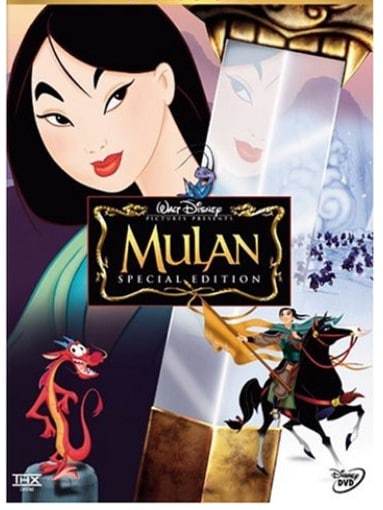
- The Little Mermaid (1989) — Florida artists contributed ink and paint support to the film.
- The Rescuers Down Under (1990) — About 10 minutes of the 77-minute sequel to 1977’s The Rescuers was animated in Florida, as well as 10 minutes of the Mickey Mouse short feature The Prince and the Pauper double-billed with the movie.
- Beauty and the Beast (1991) — Florida animators assisted in the “Be Our Guest” digital scenes of dancing forks, spoons, etc., the Beast bandaging sequence after the wolf attack, and much of “The Mob Song” and the “Something There” song.
- Aladdin (1992) – Mark Henn supervised the character of Jasmine from the Florida studio. There was also had an Aladdin unit overseen by Alex Kupershmidt. (Supervised by Glen Keane in Burbank.)
- The Lion King (1994) — Florida animators provided about 20 minutes of the film, including the “I Just Can’t Wait to be King” sequence. Two characters were supervised from Florida, Young Simba by Mark Henn and Young Nala by Aaron Blaise. Also, Alex Kupershmidt did much of the Hyena animation when Nala and Simba were cubs.
- Pocahontas (1995) — Florida animators contributed about 18 minutes to the film, including scenes involving Pocahontas’ father, Chief Powhatan, supervised by Ruben Aquino.
- The Hunchback of Notre Dame (1996) — Florida animators were only responsible for about 4 minutes of this movie, including scenes involving both Quasimodo and the villain Judge Frollo.
- Mulan (1998) — This was the first animated feature film produced primarily by Walt Disney Feature Animation Florida at Disney-MGM Studios, all while theme park guests watched. It is also the first Disney animated feature made outside of Burbank.
- The Emperor’s New Groove (2000) Additional Animation Production Services.
- Dinosaur (2000) Additional Animation Production Services.
- Atlantis: The Lost Empire (2001) Additional Animation Production Services.
- Lilo and Stitch (2002) — Made almost entirely in Florida, this film was nominated for an Academy Award for best animated feature.
- Brother Bear (2003) — The last major film to be released by the Florida studio. In development at the same time was another feature entitled My Peoples (also known as “A Few Good Ghosts” and “Once in a Blue Moon”), that was cancelled.
Other projects done at the Feature Animation Florida included the Roger Rabbit short cartoons Rollercoaster Rabbit (1990) and Trail Mix-Up (1993), the shorts John Henry (2000), Off His Rockers (1992), How to Haunt a House (1998) for Toon Disney featuring Goofy, and in 1993 “The House meets The Mouse Parts 1 and 2”, a non-Disney project for Warner Bros. Television’s Full House that had an animated Segment for “Joey’s Caricature” and Cameo. Uncredited except for Mark Henn.
Disney Feature Animation Florida also did projects such as “It’s a Small World” for Euro Disney, a Figment interactive attraction for Epcot, and Aladdin animation for the old Sega Genesis game system, and a Manatee PSA (1992). There were many other projects done in Florida by DFA Florida Special Animation that provided animation for TV commercials, theme parks, and video games.
* * * * *
Thanks, Jim! And come back next Friday for more from Jim Korkis!
In the meantime, check out his books, including his latest, The Unofficial Walt Disney World 1971 Companion: Stories of How the World Began, and Secret Stories of Walt Disney World: Things You Never You Never Knew, which reprints much material first written for this site, all published by Theme Park Press.
Follow yourfirstvisit.net on Facebook or Twitter or Pinterest!!
July 19, 2019 No Comments


